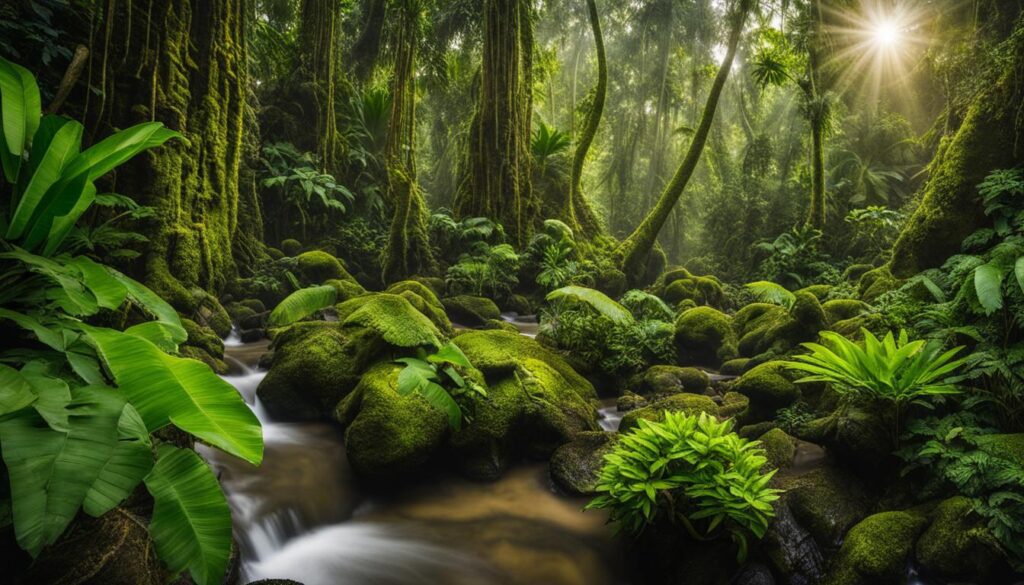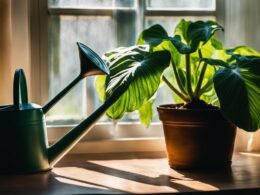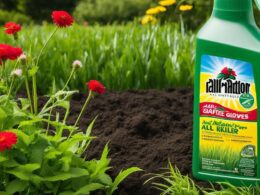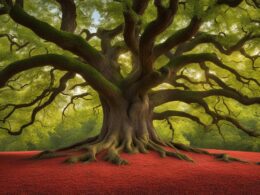Welcome to the breathtaking world of the Congo rainforest, where an abundance of plant life awaits your exploration. Spanning a vast area of 3.7 million square kilometers, this majestic rainforest is teeming with an extraordinary variety of plant species, making it a true paradise for nature enthusiasts and conservationists alike.
The Congo Basin, which encompasses countries such as Angola, Cameroon, Central African Republic, Democratic Republic of the Congo, Republic of the Congo, Burundi, Rwanda, Tanzania, and Zambia, is home to the second-largest rainforest in the world. With over 600 tree species and a staggering 10,000 animal species, this ecological gem showcases unparalleled biodiversity.
Why is the rainforest a sanctuary for such a remarkable array of flora and fauna? One answer lies in the vast expanse of the Congo rainforest, covering approximately 178 million hectares. Acting as a vital carbon sink, it plays a crucial role in combatting climate change by storing an immense amount of carbon.
However, the delicate balance of this extraordinary ecosystem is under threat. Deforestation caused by activities such as farming, logging, and industrial plantations poses a significant risk to the rich plant life that thrives here. Now, more than ever, the importance of preserving and protecting the Congo’s plant diversity cannot be overstated.
In the upcoming sections, we will delve deeper into the incredible plant life found within the Congo rainforest and explore the remarkable biodiversity that makes this awe-inspiring ecosystem a treasure worth cherishing.
Plant Life in the Congo
The Congo Basin is a haven for diverse plant life, boasting a lush and thriving ecosystem. Within the vast expanse of the equatorial rainforest, towering trees reach impressive heights of 130 to 160 feet, creating a canopy of green. This rich environment supports a multitude of plant species, contributing to the biodiversity of the region.
The central basin of the Congo is particularly abundant in native trees, which play a vital role in the local economy. Species such as mahogany, ebony, limba, wenge, agba, iroko, and sapele are highly valued for their valuable timber. These trees are sustainably harvested, providing important resources for the local communities and industries.
- Mahogany: Known for its durability and beautiful reddish-brown color, mahogany is widely used in furniture and construction.
- Ebony: Highly prized for its dense and dark wood, ebony is often used in musical instruments and luxury items.
- Limba: With its light and flexible wood, limba is favored for making plywood, furniture, and cabinets.
- Wenge: Characterized by its dark chocolate-brown color and distinctive grain pattern, wenge is commonly used in flooring and decorative objects.
- Agba: Agba wood is durable and resistant to termites, making it ideal for construction and outdoor applications.
- Iroko: Iroko wood exhibits excellent stability and resistance to decay, making it popular for boat building and outdoor furniture.
- Sapele: Sapele wood is often used as a substitute for mahogany, known for its attractive grain and versatility.
Fibrous plants like raffia and sisal are also prevalent in the Congo Basin. Raffia is known for its long leaves, which are used for weaving mats, baskets, and other crafts. Sisal, on the other hand, is well-regarded for its strong fibers, used in the production of ropes, twines, and textiles.
The rainforest is a treasure trove of medicinal plants, contributing to traditional healing practices and modern medicine. One notable example is cinchona, the plant source of quinine, a widely used antimalarial drug. Another plant of significance is rauwolfia, known for its calming and antihypertensive properties.
The Congo Basin also features copal, rubber, and palm trees, which are significant to the local economy. Copal, a resinous substance, has traditional uses in incense and varnish. Rubber is extracted from various tree species, providing a valuable raw material for a range of products. Palm trees, including the oil palm, offer edible fruits and oils that are widely used in cooking and skincare products.
Additionally, the Congo Basin’s forests, grasslands, and swamps are home to a variety of edible mushrooms and wild vegetables. These natural resources contribute to the local cuisine and provide sustenance for the communities that rely on the rainforest.
Overall, the Congo Basin is a testament to the incredible diversity of plant life. From towering timber trees to valuable medicinal plants and edible vegetation, this biodiverse region is a source of awe and wonder.
Biodiversity in the Congo Rainforest
The Congo rainforest is a biodiverse haven, providing a habitat for a diverse range of animal species. From majestic chimpanzees and bonobos to towering forest elephants and mighty gorillas, the Congo rainforest is teeming with wildlife. Various species of monkeys and baboons swing through the treetops, while African forest elephants roam the forest floor. Lions, leopards, jackals, and hippos add to the rich tapestry of animal life found in this remarkable ecosystem. Bird enthusiasts will be delighted to spot numerous bird species, adding to the vibrant chorus of the rainforest.
In the northern region’s primary forests of Uele, Aruwimi, and Ituri, rare and unique animals can be found. The elusive okapi, giant wild boars, and short antelopes roam these lush jungles, adding to the biodiversity of the Congo rainforest. Journeying to the grasslands, one encounters a different array of wildlife, including lions, leopards, wildcats, wild dogs, buffaloes, antelopes, and even black and white rhinoceroses. The rivers, lakes, and swamps are home to a thriving aquatic ecosystem, with diverse fish species like capitaine, catfish, electric fish, eels, cichlids, jellyfish, and lungfishes.
However, the remarkable biodiversity of the Congo rainforest is under threat. Increased hunting and deforestation pose significant risks to the survival of these precious animal species. Efforts must be made to protect and preserve this unique ecosystem, ensuring the survival of endangered species and maintaining the delicate balance of nature in the Congo rainforest.
Can Tall Yellow Perennial Flowers Be Found in Congo’s Rich Plant Diversity?
Yes, tall yellow perennial flowers can be found in Congo’s rich plant diversity. With its diverse ecosystems and varied climates, Congo is home to an array of stunning flora, including tall yellow perennial flowers that add vibrant bursts of color to the landscape.










